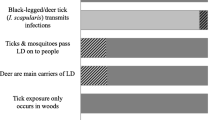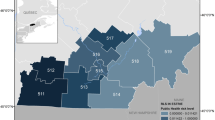Abstract
Several personal protective measures (PPMs) are recommended to prevent tick-borne diseases (TBD). We aimed to quantify the strength of seven PPMs and self-reported TBD diagnosis associations and to understand what variables modify these associations. In June–July 2018, with a cross-sectional study design, we surveyed a sample of adult Indiana state residents. Overall, 2927 participants were eligible for this analysis. All data were self-reported. We used the double robust approach of stabilized inverse probability weighting and propensity score adjustment to obtain ORs. Approximately 5% of participants (n = 142) self-reported TBD diagnosis. Practicing different PPMs ranged from 48% for treating outdoor clothing with special bug-spray to 83% for walking on established trails. Using insect repellent on exposed skin was protective against TBD diagnosis [OR (95% CI): 0.55 (0.35, 0.88)]. A thorough body/clothes check after being outdoors was also protective against TBD diagnosis [OR (95% CI): 0.40 (0.25, 0.67)]. In stratified analyses, TBD knowledge, safety worry because of ticks, avoiding outdoors because of ticks, and pet TBD risk modified the associations between different PPMs and self-reported TBD diagnosis. In the state of Indiana, thorough body/clothes check after being outdoors and use of insect repellent on exposed skin might be strongly effective in preventing TBD. The protective effect of different PPMs might be stronger among people with high TBD knowledge, high safety worry because of ticks, high avoidance of being outdoors because of ticks, and low pet TBD risk. These results might be useful in the design of intervention programs.
Similar content being viewed by others
References
Aenishaenslin, C., Michel, P., Ravel, A., Gern, L., Milord, F., Waaub, J.-P., et al. (2015). Factors associated with preventive behaviors regarding Lyme disease in Canada and Switzerland: A comparative study. BMC Public Health,15(1), 185. https://doi.org/10.1186/s12889-015-1539-2.
Bartosik, K., Kubrak, T., Olszewski, T., Jung, M., & Buczek, A. (2008). Prevention of tick bites and protection against tick-borne diseases in south-eastern Poland. Annals of Agricultural and Environmental Medicine,15(2), 181.
Bayles, B. R., Evans, G., & Allan, B. F. (2013). Knowledge and prevention of tick-borne diseases vary across an urban-to-rural human land-use gradient. Ticks and Tick-Borne Diseases,4(4), 352–358.
Beaujean, D. J., Bults, M., van Steenbergen, J. E., & Voeten, H. A. C. M. (2013). Study on public perceptions and protective behaviors regarding Lyme disease among the general public in the Netherlands: Implications for prevention programs. BMC Public Health,13(1), 225. https://doi.org/10.1186/1471-2458-13-225.
Beaujean, D. J., Gassner, F., Wong, A., Crutzen, R., & Ruwaard, D. (2013). Determinants and protective behaviours regarding tick bites among school children in the Netherlands: A cross-sectional study. BMC Public Health,13(1), 1148. https://doi.org/10.1186/1471-2458-13-1148.
Brookhart, M. A., Schneeweiss, S., Rothman, K. J., Glynn, R. J., Avorn, J., & Stürmer, T. (2006). Variable selection for propensity score models. American Journal of Epidemiology,163(12), 1149–1156.
Carroll, J. F., & Kramer, M. (2001). Different activities and footwear influence exposure to host-seeking nymphs of Ixodes scapularis and Amblyomma americanum (Acari: Ixodidae). Journal of Medical Entomology,38(4), 596–600. https://doi.org/10.1603/0022-2585-38.4.596.
Centers for Disease Control and Prevention. (2014). Behavioral risk factor surveillance system. Retrieved September 4, 2019, from https://www.cdc.gov/brfss/about/index.htm
Centers for Disease Control and Prevention. (2018a). Lyme disease data tables: Historical data. Retrieved September 24, 2019, from https://www.cdc.gov/lyme/stats/tables.html
Centers for Disease Control and Prevention. (2018b). National notifiable diseases surveillance system, 2017 Annual Tables of Infectious Disease Data. Atlanta, GA. CDC Division of Health Informatics and Surveillance. Retrieved September 9, 2019, from https://www.cdc.gov/nndss/in
Centers for Disease Control and Prevention. (2018c). National Notifiable Diseases Surveillance System. Notifiable Infectious Diseases and Conditions Data Tables. Retrieved November 22, 2019, from https://wwwn.cdc.gov/nndss/infectious-tables.html
Centers for Disease Control and Prevention. (2018d). Preventing tick bites on people. Lyme disease Web site. Retrieved May 13, 2019, from https://www.cdc.gov/lyme/prev/on_people.html
Centers for Disease Control and Prevention. (2018e). Signs and symptoms of untreated Lyme disease. Retrieved December 21, 2018, from https://www.cdc.gov/lyme/signs_symptoms/index.html
Centers for Disease Control and Prevention. (2019a). Ehrlichiosis, signs and symptoms. Retrieved May 13, 2019, from https://www.cdc.gov/ehrlichiosis/symptoms/index.html
Centers for Disease Control and Prevention. (2019b). Geographic distribution of ticks that bite humans. Retrieved August 31, 2019, from https://www.cdc.gov/ticks/geographic_distribution.html
Centers for Disease Control and Prevention. (2019c). Tickborne disease surveillance data summary. Retrieved May 13, 2019, from https://www.cdc.gov/ticks/data-summary/index.html
Centers for Disease Control and Prevention. (2019d). Tickborne diseases of the United States. Retrieved August 31, 2019, from https://www.cdc.gov/ticks/diseases/index.html
Connally, N. P., Durante, A. J., Yousey-Hindes, K. M., Meek, J. I., Nelson, R. S., & Heimer, R. (2009). Peridomestic Lyme disease prevention: Results of a population-based case–control study. American Journal of Preventive Medicine,37(3), 201–206. https://doi.org/10.1016/j.amepre.2009.04.026.
Donohoe, H., Omodior, O., & Roe, J. (2018). Tick-borne disease occupational risks and behaviors of Florida Fish, Wildlife, and Parks Service employees–A health belief model perspective. Journal of Outdoor Recreation and Tourism,22, 9–17.
Faulde, M. K., Rutenfranz, M., Keth, A., Hepke, J., Rogge, M., & Görner, A. (2015). Pilot study assessing the effectiveness of factory-treated, long-lasting permethrin-impregnated clothing for the prevention of tick bites during occupational tick exposure in highly infested military training areas, Germany. Parasitology Research,114(2), 671–678. https://doi.org/10.1007/s00436-014-4232-y.
Finch, C., Al-Damluji, M. S., Krause, P. J., Niccolai, L., Steeves, T., O’Keefe, C. F., et al. (2014). Integrated assessment of behavioral and environmental risk factors for Lyme disease infection on Block Island, Rhode Island. PLoS ONE,9(1), e84758. https://doi.org/10.1371/journal.pone.0084758.
Gardulf, A., Wohlfart, I., & Gustafson, R. (2004). A prospective cross-over field trial shows protection of lemon eucalyptus extract against tick bites. Journal of Medical Entomology,41(6), 1064–1067. https://doi.org/10.1603/0022-2585-41.6.1064.
Glass, G. E., Schwartz, B. S., Morgan, J. M., III, Johnson, D. T., Noy, P. M., & Israel, E. (1995). Environmental risk factors for Lyme disease identified with geographic information systems. American Journal of Public Health,85(7), 944–948. https://doi.org/10.2105/ajph.85.7.944.
Heen, M. S., Lieberman, J. D., & Miethe, T. D. (2014). A comparison of different online sampling approaches for generating national samples. Center for Crime and Justice Policy,1, 1–8.
Hernán MA, & Robins JM. (2019). Causal inference. Boca Raton: Chapman & Hall/CRC, forthcoming. Retrieved from https://www.hsph.harvard.edu/miguel-hernan/causal-inference-book/
Herrington, J. E., Jr. (2004). Risk perceptions regarding ticks and Lyme disease: A national survey. American Journal of Preventive Medicine,26(2), 135–140.
Mead, P., Hook, S., Niesobecki, S., Ray, J., Meek, J., Delorey, M., et al. (2018). Risk factors for tick exposure in suburban settings in the Northeastern United States. Ticks and Tick-Borne Diseases,9(2), 319–324.
Mowbray, F., Amlôt, R., & Rubin, G. J. (2014). Predictors of protective behaviour against ticks in the UK: A mixed methods study. Ticks and Tick-Borne Diseases,5(4), 392–400. https://doi.org/10.1016/j.ttbdis.2014.01.006.
Omodior, O., Kianersi, S., & Luetke, M. (2019). Prevalence of risk and protective factors for tick exposure and tick-borne disease among residents of Indiana. Journal of Public Health Management and Practice,21(1), S76.
Omodior, O., Pennington-Gray, L., & Donohoe, H. (2015). Efficacy of the theory of planned behavior in predicting the intention to engage in tick-borne disease personal protective behavior amongst visitors to an outdoor recreation center. Journal of Park and Recreation Administration,33(2), 37–53.
Omodior, O., Pennington-Gray, L., & Thapa, B. (2017). Modeling insect-repellent use for chikungunya disease prevention among US-Caribbean travelers. International Journal of Travel Medicine and Global Health,5(4), 125–134.
Phillips, C. B., Liang, M. H., Sangha, O., Wright, E. A., Fossel, A. H., Lew, R. A., et al. (2001). Lyme disease and preventive behaviors in residents of Nantucket Island, Massachusetts. American Journal of Preventive Medicine,20(3), 219–224.
Piesman, J., & Eisen, L. (2008). Prevention of tick-borne diseases. Annual Review of Entomology,53, 323–343. https://doi.org/10.1146/annurev.ento.53.103106.093429.
Qualtrics. (2018). Qualtrics 2018. Retrieved December 21, 2018, from https://uits.iu.edu/qualtrics.
Richardson, M., Khouja, C., & Sutcliffe, K. (2018). Interventions to prevent Lyme disease in humans: A systematic review. Preventive Medicine Reports. https://doi.org/10.1016/j.pmedr.2018.11.004.
Rubin, D. B., & Thomas, N. (1996). Matching using estimated propensity scores: Relating theory to practice. Biometrics,52(1), 249–264.
Schiffman, E. K., McLaughlin, C., Ray, J. A. E., Kemperman, M. M., Hinckley, A. F., & Friedlander, H. G. (2009). Neitzel DF (2018) Underreporting of Lyme and other tick-borne diseases in residents of a high-incidence county, Minnesota. Zoonoses and Public Health,65(2), 230–237.
Shaw, S. E., Day, M. J., Birtles, R. J., & Breitschwerdt, E. B. (2001). Tick-borne infectious diseases of dogs. Trends in Parasitology,17(2), 74–80.
Slunge, D., & Boman, A. (2018). Learning to live with ticks? The role of exposure and risk perceptions in protective behaviour against tick-borne diseases. PLoS ONE,13(6), e0198286. https://doi.org/10.1371/journal.pone.0198286.
Smith, G., Wileyto, E. P., Hopkins, R. B., Cherry, B. R., & Maher, J. P. (2001). Risk factors for lyme disease in Chester County, Pennsylvania. Public Health Reports,116(1), 146. https://doi.org/10.1093/phr/116.S1.146.
Social Research Center. (2019). New south wales population Health Survey. Retrieved May 25, 2019, from https://www.srcentre.com.au/our-research/new-south-wales-population-health-survey
Steiner, F. E., Pinger, R. R., Vann, C. N., Abley, M. J., Sullivan, B., Grindle, N., et al. (2014). Detection of Anaplasma phagocytophilum and Babesia odocoilei DNA in Ixodes scapularis (Acari: Ixodidae) collected in Indiana. Journal of Medical Entomology,43(2), 437–442.
Vázquez, M., Muehlenbein, C., Cartter, M., Hayes, E. B., Ertel, S., & Shapiro, E. D. (2008). Effectiveness of personal protective measures to prevent Lyme disease. Emerging Infectious Diseases,14(2), 210. https://doi.org/10.3201/eid1402.070725.
Acknowledgements
We acknowledge the Environmental Resilience Institute (ERI) and the Indiana University’s Prepared for Environmental Change (PfEC) Grand Challenge initiative for supporting and funding the research project. The Indiana University IRB approved the study protocol (Protocol No.: 1806808759). No financial disclosures were reported by the authors of this paper.
Funding
This project was supported by the Environmental Resilience Institute (ERI), funded by Indiana University’s Prepared for Environmental Change (PfEC) Grand Challenge initiative.
Author information
Authors and Affiliations
Corresponding author
Ethics declarations
Conflict of interest
The authors declare that they have no conflict of interest.
Additional information
Publisher's Note
Springer Nature remains neutral with regard to jurisdictional claims in published maps and institutional affiliations.
Electronic supplementary material
Below is the link to the electronic supplementary material.
Rights and permissions
About this article
Cite this article
Kianersi, S., Luetke, M., Wolfe, C.G. et al. Associations Between Personal Protective Measures and Self-Reported Tick-Borne Disease Diagnosis in Indiana Residents. J Community Health 45, 739–750 (2020). https://doi.org/10.1007/s10900-020-00789-w
Published:
Issue Date:
DOI: https://doi.org/10.1007/s10900-020-00789-w




